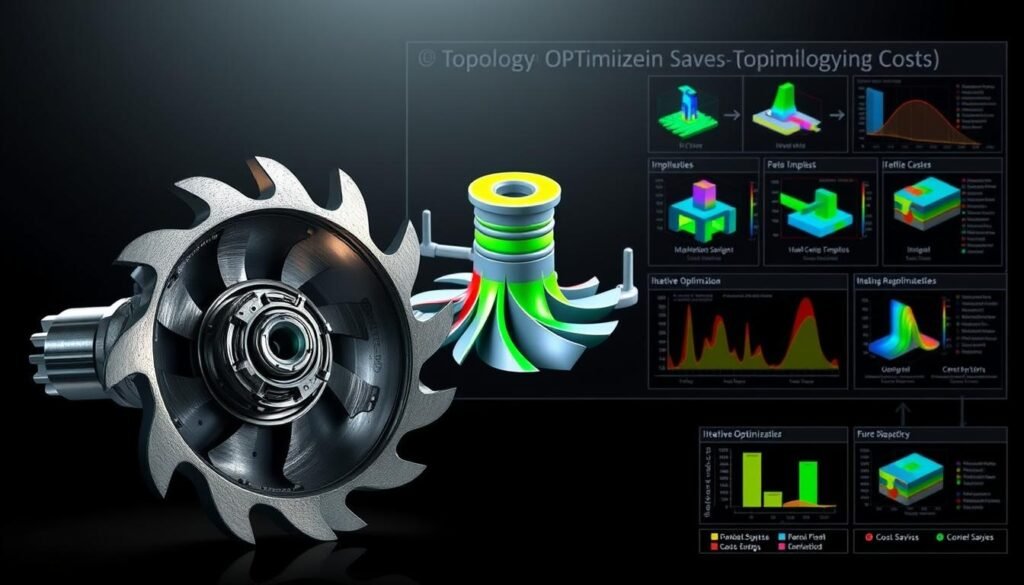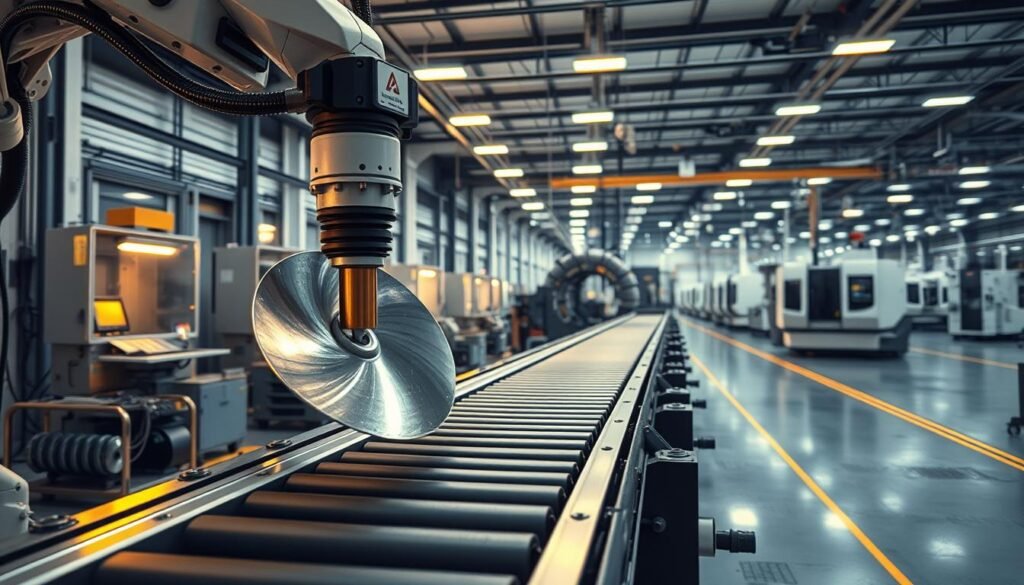Reducing costs for impeller manufacturing is a big deal for many industries. Topology optimization helps make impeller designs cheaper and better. It’s a way to use computers to find the best design for an impeller, cutting down on waste and costs.
Designing impellers well is key to saving money and making systems work better. With topology optimization, makers can design impellers that are just right for their job. This means less waste and lower costs. It also makes systems run more smoothly.
Knowing how topology optimization works is important for those wanting to save on impeller costs. Using this method, companies can make impellers that are both efficient and affordable. This leads to big savings and better system performance. Adding topology optimization to the design process can greatly reduce costs and boost efficiency.
Understanding Topology Optimization in Impeller Design
Topology optimization is key in making impellers more efficient and affordable. It uses algorithms to find the best design for impellers. This leads to less material use and better performance.
The main goal is to use as little material as possible. Yet, the impeller must stay strong and work well. This is what topology optimization aims for.
Using topology optimization brings many benefits. It cuts down on material costs, boosts performance, and makes things more efficient. To get these benefits, manufacturers must think about several important things. These include:
- Flow rate and pressure needs
- Material types and limits
- How it can be made
- What it needs to do and how well it should do it
By looking at these factors and using topology optimization, makers can make impellers that are both good and cheap. This is very important today because companies want to save money and work better.
Topology optimization is a big help for makers of impellers. It lets them make new and better designs for different industries. As it gets better, we’ll see even more ways it helps save money and improve how things work.
By using topology optimization well, makers can get a lot of good things. They can make things work better, use less, and save money. As more people need efficient and affordable impellers, using topology optimization will become even more important.
| Design Parameter | Описание |
|---|---|
| Скорость потока | The rate at which fluid flows through the impeller |
| Pressure Requirements | The pressure levels that the impeller must withstand |
| Material Properties | The characteristics of the materials used in impeller construction |
How to Reduce the Manufacturing Cost of Impellers Through Topology Optimization
Companies involved in Производство рабочего колеса often look for ways to cut costs. One effective method is using topology optimization in design. This technique helps create complex shapes that use less material but keep performance high.
Using cost reduction strategies through topology optimization can greatly lower production costs. It does this by designing impellers to need less material. This also cuts down on waste and makes the production process smoother.

When using topology optimization for Производство рабочего колеса, consider a few things:
- Выбор материала: The right materials can greatly affect production costs.
- Production volume: Designing for large production runs can lower costs per item.
- Manufacturing process: Choosing the most efficient process also helps cut costs.
By thinking about these points and using topology optimization, companies can make impellers that are both high-quality and affordable. This makes them more competitive in the market.
Implementation Strategies for Optimized Impeller Production
Creating efficient and cost-effective impeller production is key. To do this, manufacturers need to look at several things. These include using the right software, choosing the best materials, and adjusting the manufacturing process. The goal is to make high-quality impellers while keeping costs and environmental impact low.
Advanced software tools are vital for designing better impellers. Tools like finite element analysis and computational fluid dynamics help simulate how impellers work. This lets manufacturers spot areas for improvement and design better impellers.
Software Tools and Technologies
- Finite element analysis
- Вычислительная динамика жидкости
- Computer-aided design (CAD) software
Material selection is also important for making impellers efficiently. Manufacturers need to pick materials that are strong, last long, and are cost-effective. The manufacturing process must also be adjusted to fit the new design. This ensures the final product meets quality and performance standards.

Material Selection Considerations
When picking materials, manufacturers should think about corrosion resistance, теплопроводность, and strength. The material must handle the stresses and conditions the impeller faces during use.
| Материал | Характеристики | Advantages |
|---|---|---|
| Нержавеющая сталь | Коррозионная устойчивость, high strength | Долговечный, resistant to corrosion |
| Алюминий | Легкий вес, high thermal conductivity | Low cost, easy to manufacture |
By focusing on these areas and using optimized design and manufacturing, manufacturers can make their impeller production more efficient and cost-effective. This leads to better competitiveness and profits in the market.
Measuring Cost Reduction and Performance Impact
To see how well topology optimization works in impeller design, we need to look at cost savings and how it improves performance. We check things like manufacturing costs, how much material is used, and how the impeller does in real use. This helps us see if our optimization plans are working and where we can get better.
Some important things to watch include:
- Cost reduction: We compare the cost of making optimized impellers to the old ones.
- Performance impact: We check how well the impeller works, like its efficiency and pressure.
- Impeller design: The design of the impeller affects its cost and performance. Topology optimization can help use less material and work better.
By looking at these, we learn a lot about our optimization success. Regular monitoring and analysis help us find ways to get even better. This ensures our optimized impellers meet high performance standards.
Measuring cost savings and performance is key to making topology optimization in impeller design a success. With the right metrics and tools, manufacturers can make their impeller design and production better. This leads to better performance, lower costs, and more success in the market.
Заключение: Maximizing Manufacturing Efficiency Through Optimization
Topology optimization has changed the game for impeller manufacturing costs. It helps designers create better impellers. This leads to better performance, less waste, and more productivity.
As the industry grows, topology optimization will play a bigger role in impeller design. By using this method, makers can keep up with demand. They can make high-quality products at a lower cost.
